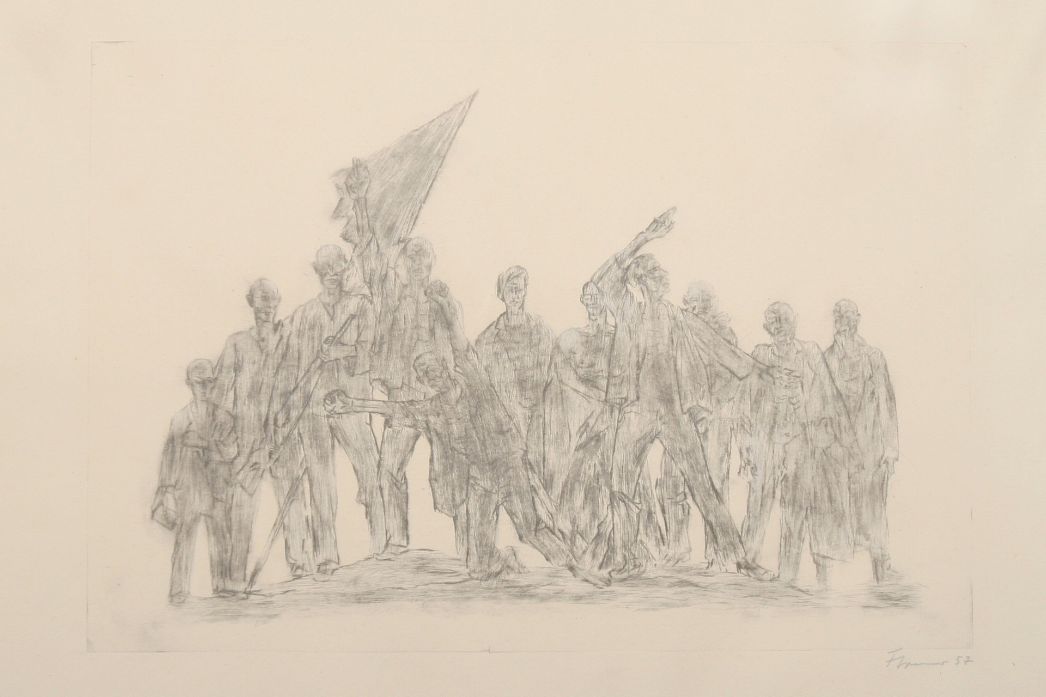
The National Buchenwald Memorial of the German Democratic Republic was inaugurated on 14 September 1958. The debate over the appropriate design of the camp grounds and memorial facilities had dragged on for several years, guided not so much by historical or aesthetic considerations as by political motivations. From struggle and martyrdom a better, socialist Germany had arisen—such was the message to be conveyed. The figural group in front of the bell tower (“Tower of Freedom”) was of central importance in this narrative. Fritz Cremer’s original design, however, sparked a fierce dispute that led the sculptor to change his concept.
Having lost close friends under the National Socialist dictatorship, Fritz Cremer had already reflected on the Nazi crimes in depth before receiving the invitation to participate in the contest for the design of the Buchenwald monument. In 1952, his proposal—which he submitted in collaboration with the writer Bertolt Brecht and the landscape architect Reinhold Lingner—was awarded a prize by the Memorial Planning Commission (of the Central Executive Committee of the VVN) under the chairmanship of Minister President Otto Grotewohl. Cremer’s sculpture was to be realized along with the landscape architecture of another winning design.
Yet there was also criticism of Cremer’s sculpture for Buchenwald. In keeping with the art doctrine of Socialist Realism, his figural group was assessed as insufficiently optimistic and confident of success. The critics also found fault with the fact that the work depicted neither the leading role attributed to the German Communist Party in the German antifascist resistance struggle nor that of the Soviet Union and the historically necessary victory of Communism on the global scale. The political and art-political disputes delayed the monument’s realization for years: between 1952 and 1954, Fritz Cremer submitted three designs, creating altogether 42 individual figures in the course of the work.
His first proposal called for only eight figures. They were accorded equal status; none stands out from the others. Marked by the injustices they have suffered, they fight an invisible enemy. Oppressed and abased, they stand there unbroken, their very presence an accusation. No base elevates them. Cremer took direct orientation from Auguste Rodin’s The Burghers of Calais executed in 1884/85, a figural group likewise not hierarchically arranged.
The artwork is an etching gone over with pencil, executed by Cremer in 1957 as a study for his third proposal, submitted in 1958. The fine lines develop the group’s structure with precision: the drawing conveys the artist’s aesthetic decisions with regard to the figural arrangement, the expansive movements, and the details of the individual elements. Now the monument has a pedestal—a low one, so that the figures will stand in the midst of the people gathered around it. At the same time, the artist defied the specified art-political doctrine by developing a broad panorama. In eleven figures he condensed “the entire drama of human sensibilities under inhumane conditions” in a “Man Falling”, a “Man Shouting”, a “Man Swearing”, a “Doubter”, a “Cynic”, etc.
As part of his multifaceted sculptural and graphic oeuvre, Fritz Cremer would go on to produce monuments for the Ravensbrück and Mauthausen Memorials as well. The Buchenwald group was his most well-known work. It was instrumentalized like no other monument for the goals of the party and the government: the foremost concerns were the formation of civil loyalty and the legitimization of the German Democratic Republic—not the confrontation with and reassessment of the National Socialist past.
Between 2002 and 2005, the group had to undergo thorough conservational treatment owing to damage caused by corrosion. These measures restored the figures’ original vibrancy and Brechtian typification.
Biography
Fritz Cremer was born in Arnsberg an der Ruhr on 22 October 1906. He grew up in a miners’ family. His father died when he was one year old; he lost his mother when he was fifteen. He completed training as a stone sculptor in Essen and in 1929 went to Berlin, where, following a trial semester, he studied art at the Vereinigte Staatsschule für freie und angewandte Kunst (Berlin-Charlottenburg) until 1937, in the later years (1934–1938) as a master pupil of Wilhelm Gerstel. Having been socialized in the working-class milieu of the Ruhr region, Cremer had been a member of the Communist Youth Association since 1926, joined the Communist party in 1929, and co-founded of the Red Students’ League at the art academy. As an award recipient in the contest for the “Prussian State Prize for Sculpture” he had a studio at the Villa Massimo in Rome in 1937/38. He became a soldier in the Wehrmacht in 1940 and in 1944 was taken prisoner by the Yugoslavs.
After his release, Cremer taught at the Hochschule für angewandte Kunst in Vienna from 1946 to 1950. In 1951 he was called to the Akademie der Künste der DDR in Berlin. Fritz Cremer died in Berlin on 1 September 1993.


